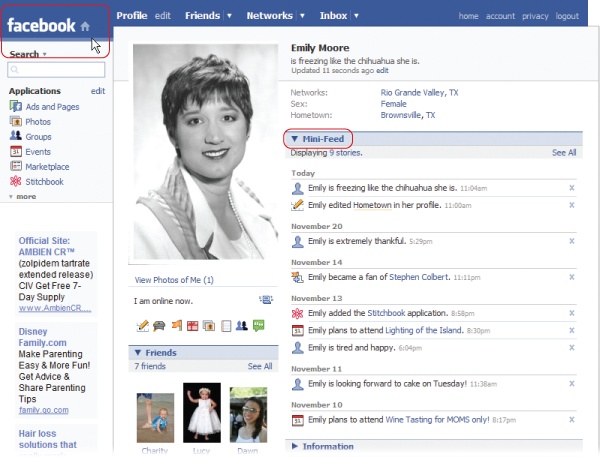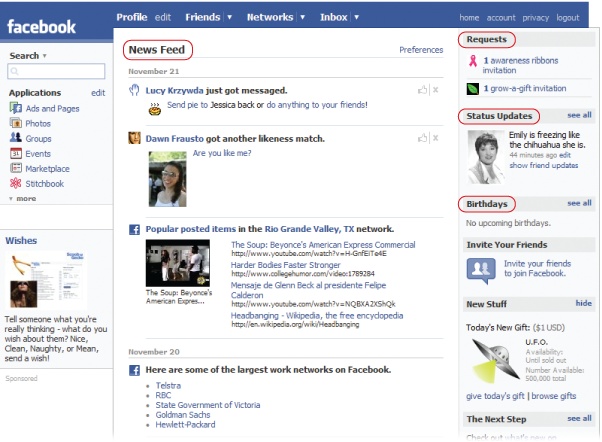Introduction
Maybe a Facebook invitation showed up in your email inbox and you’re trying to decide whether to join the site. Maybe you were alarmed when you heard your kids mention poking each other on Facebook. Or maybe the Wall Street buzz caught your attention when Facebook—a whippersnapper of a Web site that didn’t even exist until 2004—clocked in at a breathtaking value of $15 billion.
However you heard about it, everybody seems to be talking about Facebook. And for good reason: In an astonishingly short period of time, Facebook has grown from an online yearbook for college kids to an Internet juggernaut with over 50 million members.
So what is Facebook, anyway? It’s a free-to-use, wildly popular social networking site—which means it’s a way to connect with other people—that combines the best of blogs, online forums and groups, photo sharing, and much more. By tracking the connections its members make with each other, Facebook makes it easy to find and contact people—everyone from old friends and roommates to new customers, new bosses, and even folks you’ve never met before who share your interests.
Note
If you’re thinking that Facebook sounds a lot like MySpace, you’re right. The difference? In a word, positioning. Facebook does pretty much the same stuff as MySpace, but in a cleaner, more controlled, more professional way. So while My- Space’s blinking, flashing, online teen haven boasts nearly twice as many members as Facebook, Facebook’s membership is rapidly catching up. And over half of all new Facebook members count themselves among the 25-and-older crowd, so it’s not just for college kids anymore.
How Facebook Works
First, you type in your personal and professional information—as much or as little as you’re comfortable with. (Most folks add extras such as photos, videos, and audio clips.) Then, you establish connections with groups of Facebook members, like everybody who went to your alma mater, or everybody who works at your company. Finally, you add individual connections to other members, such as the guys on your soccer team, your next-door neighbor, and the two or three old flames you’re still speaking to. Bingo: instant access to the personal and professional details of all the folks you’re connected to, and the folks they’re connected to, and so on. You can think of Facebook as a 50-million-plus-entry searchable Rolodex—on steroids.
The two parts of the site you interact with most often are:
Your profile. Your profile is the page that other Facebook members—friends, family members, co-workers, long-lost roommates, potential bosses, and so on—see when they look you up on Facebook (you can, of course, view your own profile, too). The mini-feed (Mini-feeds: What You’re Doing) on your profile makes it easy for your friends to see what you’re up to. The figure below shows a sample profile.
Your home page. The majority of your Facebook home page is taken up by a news feed (Types of Updates) that chronicles your friends’ Facebook activities. The right side of the page shows you stuff you might want to take action on: requests your friends have made, upcoming birthdays, and so on. It also lists any requests—to befriend someone or to install an application (Facebook Applications: An Overview) one of your friends found useful, for example—that require your attention. To get to your home page, click the word “facebook” in the top-left corner of any Facebook screen, or click the “home” link in the upper right. Missing Manuals on Facebook.com shows you what a typical home page looks like.
What You Can Do With Facebook
Like all social networking sites, Facebook blurs the line between personal and professional: Your boss is just as likely as your kids to be on Facebook. Still, most folks focus on either professional or personal stuff when they’re on the site. The following sections list some of the things you can do on Facebook.
Social Activities
Facebook began life as a social networking site for college kids (it was started by a Harvard student), and personal interactions are still the main reason people sign up. You can:
Look up (and be looked up by) long-lost pals. Facebook wouldn’t be very useful if no one used their real names—you wouldn’t be able to find anybody! But since it’s fun to find people and have them find you (and because Facebook’s official policy requires truthfulness), members tend to provide their real names, photos, and personal details. Chapter 3 teaches you how to search for people on Facebook.
Make new friends. Facebook makes it easy to search out and contact folks with similar interests, whether you like Pedro Almodóvar movies or are frustrated with Geometry 102. And because your personal info is available for other Facebook members to see, you can learn a little about someone before you decide to contact or befriend him. Online special-interest groups (Chapter 6) let you exchange views with like-minded Facebook members, and events (Chapter 7) let you arrange face-to-face meetings with other members.
Keep in touch with far-flung friends and family. Other Facebook members can sign up for regular updates from you. For example, you can send out party updates to fellow students stuck in study hall, or photos of your new granddaughter. Likewise, you can sign up to get updates about what your friends and family members are doing. Chapter 5 teaches you all about automatic updates.
Make yourself heard. Facebook’s blogging feature (called notes—Creating Notes (Blogs)) lets you put text and photos on your profile. Think online journal—on steroids.
Buy and sell stuff.Marketplace (Chapter 8), Facebook’s answer to classified ads, lets you buy and sell stuff online using a credit card (see Chapter 8).
Keep tabs on your kids. Facebook started out as a way for students to meet online, and it’s still big with college and high school kids. Getting acquainted with Facebook not only helps you understand the language your kids are speaking; it also gives you a frank look into their online social lives.
Professional Uses for Facebook
You don’t have to be out of work to benefit from social networking. More and more professionals are turning to Facebook to mingle, headhunt, advertise, and work more effectively. Here are some of the work-related things you can do on Facebook:
Find a gig. The resumé you post on Facebook can be as extensive as you want (headhunters use Facebook, too), and there’s always the want ads in Facebook’s Marketplace (Chapter 8). But because jobs often go to the best-qualified friend-of-a-friend, Facebook’s ability to show you who’s friends with who—maybe one of your friends knows the hiring manager—can be even more useful.
Find an employee. Facebook can help you recruit new hires and even vet them (see Chapter 9).
Keep up-to-date on team projects. Subscribing to feeds (Types of Updates) and notifications (Customizing Your Mini-feed) keep you in the loop regarding upcoming deadlines and other details, such as whether team members on the other side of the building are still online or have left for the day.
Collaborate. Use Facebook’s walls (Writing on Walls),notes (Creating Notes (Blogs)), and groups (Chapter 6) to exchange ideas, photos, and more; messages (Sending Messages) to send email; and events (Chapter 7) to schedule meetings and lunch dates.
Market yourself, your products, or your company. For relatively little scratch, Facebook gives you several ways to promote things:
Pages are special interactive profiles for companies, bands, celebrities, and nonprofit organizations, and you can create them for free.
Social ads can include graphics and text; they appear in Facebook’s ad space (the lower-left part of any screen), as well as in selected members’ news feeds.
Polls are questions you can ask specifically targeted members.
Big-bucks sponsor companies have even more marketing options. Chapter 11 explains all your choices.
About This Book
Facebook is a terrifically fun and useful site, and compared to a lot of other Web sites, it’s remarkably easy to use. But that’s true only if you already know what you want to do on Facebook, and—most important—why.
That’s where this book comes in. This is the book you should have been able to download when you registered for Facebook. It explains what kinds of things you can do on Facebook, and how to go about doing them. You’ll find tips for diving headfirst into Facebook without looking like a newbie, keeping in touch with your friends, expanding your social circle, and using Facebook as a poor man’s business collaboration tool. This book also guides you through the staggering forest of privacy options so you can get the most out of Facebook with the least amount of risk (see Chapter 13).
This book is designed for readers of every skill level, from I-just-plugged-in-my-first-computer-yesterday to Internet expert. Concise intros lead you into step-by-step instructions of how to get stuff done. The Notes scattered throughout the text give you alternatives and additional info, and the Tips help you avoid problems.
Missing Manuals on Facebook.com
You can find Missing Manuals own home on Facebook by typing Missing Manuals into the Search box in the upper-left of any Facebook screen. Use the Page’s wall (Writing on Walls) or discussion board (Browsing for Groups) to post feedback about this book or any Missing Manual. And the Page is a great place to meet other folks who are fans of Missing Manuals—or to become a fan yourself (see Becoming a Fan).
About MissingManuals.com
At the missingmanuals.com Web site, you’ll find articles, tips, and updates to this book. Click the “Missing CD-ROMs” link, and then click this book’s title to see a neat chapter-by-chapter list of all the Web sites mentioned in these pages.
You’re invited and encouraged to submit corrections and updates for this book. In an effort to keep it as up-to-date and accurate as possible, each time we print more copies of this book, we’ll make any confirmed corrections you’ve suggested. We’ll also note such changes on the Web site, so you can mark important corrections in your own copy of the book, if you like. (Click the book’s name, and then click the “View/Submit Errata” link to see the changes.)
In the meantime, we’d love to hear your suggestions for new books in the Missing Manual line. There’s a place for that on the Web site, too, as well as a place to sign up for free email notification of new titles in the series.
While you’re online, you can also register this book at www.oreilly.com (you can jump directly to the registration page by going here: http://tinyurl/yo82k3). Registering means we can send you updates about this book, and you’ll be eligible for special offers like discounts on future editions of Facebook: The Missing Manual.
Safari® Books Online
When you see a Safari® Books Online icon on the cover of your favorite technology book, that means the book is available online through the O’Reilly Network Safari Bookshelf.
Safari offers a solution that’s better than e-Books. It’s a virtual library that lets you easily search thousands of top tech books, cut and paste code samples, download chapters, and find quick answers when you need the most accurate, current information. Try it free at http://safari.oreilly.com.
Get Facebook: The Missing Manual now with the O’Reilly learning platform.
O’Reilly members experience books, live events, courses curated by job role, and more from O’Reilly and nearly 200 top publishers.



